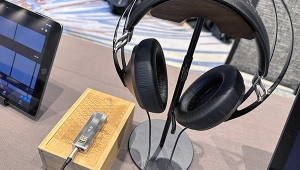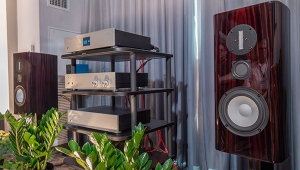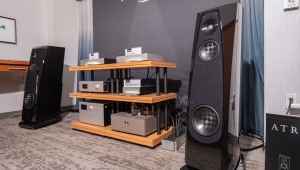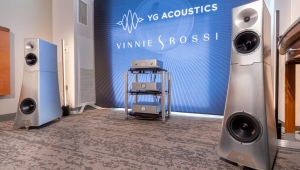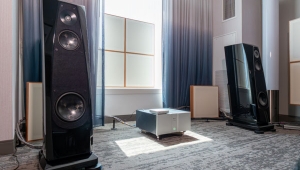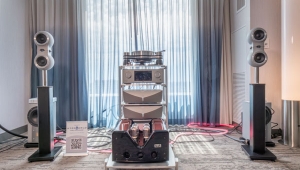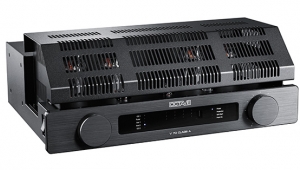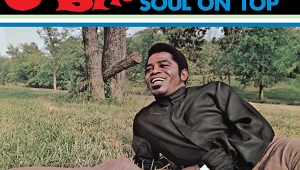| Columns Retired Columns & Blogs |
Bryston 7B NRB-THX, ST, & SST monoblock power amplifier 7ST Measurements
Sidebar 4: 7ST Measurements
Following its one-hour, 1/3-power preconditioning, the Bryston 7B was hot, though not unusually so considering its rated power output. I ran a complete set of measurements on each on the 7B-ST in its series mode (recommended for 3-8 ohm loads), with selected measurements in the parallel configuration (including the 2 ohm tests). Most of the measurements were made in the balanced mode this time around, though a number of significant measurements were repeated in the unbalanced mode.
The input impedance of the Bryston measured 16.7k ohms, balanced and 48.9k ohms, unbalanced (essentially the same in the parallel configuration). The gain was 23.3dB balanced, 29.3dB unbalanced. The output impedance was low—a maximum of 0.05 ohms at 20Hz and 1kHz and 0.14-0.16 ohms at 20kHz, depending on test conditions. This suggests a very consistent performance with a wide range of loudspeakers, at least with respect to overall amplifier/loudspeaker frequency response. The Bryston's DC offset was a negligible 1.7mV. Signal/noise (unweighted ref. 1W into 8 ohms) measured 92dB over a bandwidth of 22Hz-22kHz, 84dB from 10Hz-500kHz, and 94dB, A-weighted (the unbalanced measurements were essentially the same). The 7B was non-inverting, a positive impulse at the input remaining positive at the output. In its balanced mode, XLR pin 2 was positive.
Fig.1 shows the frequency response of the 7B. In the parallel mode—not shown, the response was a little flatter on the top end, down 0.1dB at 50kHz into 8 ohms and less than 0.25dB at 50kHz into 4 ohms. The 10kHz squarewave response is shown in fig.2. The Bryston 7B-ST has an excellent risetime with only a slight overshoot apparent on the bottom half of the wave (this is hard to spot on the trace shown and was barely visible on an oscilloscope). The 1kHz squarewave (not shown) was virtually perfect. (The squarewave responses in the parallel configuration, not shown, were virtually the same).

Fig.1 Bryston 7B-ST, frequency response at (from top to bottom at 30kHz): 1W into 8 ohms, series, balanced; series, balanced, at 2.83V into simulated speaker load; and at 2W into 4 ohms, series, balanced (0.5dB/vertical div.).

Fig.2 Bryston 7B-ST, small-signal 10kHz squarewave into 8 ohms.
As with the 3B-ST, the low-power THD+noise vs frequency results in fig.3 were taken at ten times higher than normal output. This was the only way to minimize the effects of low-level noise on the reading. Only the result into the simulated load shows any peculiarity. And the maximum distortion is still below 0.3%.

Fig.3 Bryston 7B-ST, THD+noise vs frequency at (from top to bottom at 5kHz): 9V into simulated speaker load; 40W into 2 ohms; 10W into 8 ohms, unbalanced; 20W into 4 ohms; and 10W into 8 ohms balanced (all series drive).
The plot of the distortion waveform, at 1kHz, shown in fig.4 was taken at 4 ohms into 200W. At lower power levels the distortion was buried in the noise. The distortion is primarily third-harmonic (and remains third-harmonic in the parallel mode driving 2 ohms, not shown).

Fig.4 Bryston 7B-ST, 1kHz waveform at 200W into 4 ohms (top); distortion and noise waveform with fundamental notched out (bottom, not to scale).
Because of the extremely high power capability of the 7B-ST, I limited the high-power output spectrum measurements below, to 200W maximum instead of the 2/3 power normally attempted. Since this measurement takes a little longer than the clipping measurement, I had no desire to blow up our test bench load! For the same reason, the 50Hz spectrum response into a simulated real load was not taken. Fig.5 shows the Bryston's output spectrum driving 50Hz at 200W into 4 ohm. All of the artifacts lie below -90dB (0.003%). The same is true of fig.6, which shows the intermodulation artifacts resulting from driving a combined 19+20kHz signal at 200W into 8 ohms. The response for 200W into 4 ohms is not shown; all of the artifacts were at or below the levels in fig.6.

Fig.5 Bryston 7B-ST, spectrum of 50Hz sinewave, DC-1kHz, at 200W into 4 ohms (linear frequency scale).

Fig.6 Bryston 7B-ST, HF intermodulation spectrum, DC-22kHz, 19+20kHz at 200W into 8 ohms (linear frequency scale).
The manner in which THD+noise changed with output power for the 7B (at 1kHz) is shown in fig.7. The actual discrete clipping-point measurements (clipping defined as the 1% distortion) were 613W into 8 ohms (27.9dBW), 954W into 4 ohms (26.8dBW), and 595W into 2 ohms (21.7dBW). (The line voltage for these measurements varied between 118V and 119V; the readings for 4 and 8 ohm loads were taken in the series configuration and the 2 ohm load in the parallel connection).

Fig.7 Bryston 7B-ST, distortion (%) vs output power into (from bottom to top at 100W): 8 ohms, series; 4 ohms, series; and 2 ohms, parallel.
The measured performance of the Bryston 7B-ST, particularly its tremendous power output with very low distortion, was first-class.—Thomas J. Norton
- Log in or register to post comments
























